► We follow Porsche through winter testing
► The new Boxster gets added turbo and 718 badge
► Expected to hit the market in April 2016
When your new Boxster arrives later this spring, spare a thought for the winter test team. These are the only guys we know who, when the thermometer reads minus six, complain that it’s too warm. But their work is crucial to the Boxster’s chassis DNA. At a time when the swapping of two cylinders for one charger will been seen by some purists as a deal with the devil, woe betide them if they drop the dynamic ball at the same time.
I join the Boxster team in Yellowknife, a thriving town within spitting distance of the Arctic Circle, where frozen lakes provide ideal proving conditions for a pre-production shakedown. Except they don’t, because of the balmy temperature. The ice is 30cm thick at its sturdiest – 20cm too thin even for these prime lightweight ambassadors of German craftsmanship.
Alex Ernst, Porsche’s long-standing master of ceremony in all sign-off drive matters, nonetheless keeps his cool. ‘We’ll check out a local road that dead-ends at a remote parking spot,’ he says. ‘As long as there is no traffic, it’s safe to go a little faster.’ A little faster? These words leave plenty of room for interpretation. Alex’s version of faster was defined by a driving-school instructor named Walter Röhrl, who took the young engineer under his wing some 30 years ago. Today’s passenger is not aware of the Röhrl connection when the PSM warning light comes on and the clutch drops at 3000rpm.
It’s a relatively short run from the main drag down to lover’s paradise, but the hazy twilight makes contours blur, and the white serpent ahead looks vague to everyone but the man with Röntgen eyes and Houdini’s speed of reaction. It’s mainly second- and third-gear stuff, a seemingly endless giant slalom with spindly fir trees acting as gates, and BYO safety nets.
We’re in the base model Boxster, a compact 2.0 litres of combustion chamber lungs, manual transmission, standard suspension, 19in winter tyres, zero driver aids. As if this driver needed aids. Or a totally overwhelmed starry-eyed passenger who, in the back of his mind, is tearing up his licence corner by corner, again and again. We experience man fusing with machine in total sychronicity, and there is no go-pro camera to jettison these moments into the You Tube orbit.
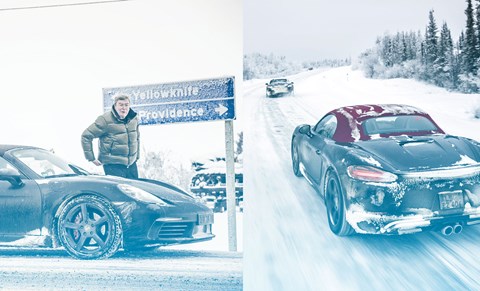
But this is not a driver training course. We travelled to Canada to zoom in on the new Porsche 718, which comes to market in April as Boxster and six months later as Cayman. The 718 moniker was inspired by the mid-engined lightweight street-legal racer and serial trophy winner between 1957 and 1964. Much more significant than the new model designation is the fact that coupe and roadster are about to swap position. The plan is to price the soft-top about £1000 above the metal-top, which was significantly more expensive when first launched in 2005.
Strategically, this is no mean feat, but what’s the thinking? ‘We were facing a complex task,’ recalls project leader Jan Roth. ‘Marketing wanted to move the mid-engined twins further away from the rear-engined 911. The dedicated means to this end is the new four-cylinder boxer. Why not a smaller displacement flat-six? Because now that we are introducing turbocharging across the board, it would have been impossible to package the bigger powerplant. Believe me – it was difficult enough to find space for the flat-four and for the related extra intake and exhaust plumbing, not to mention the complex intercooler assembly. For these reasons alone, the six was never on our radar.’
Leafing through the Porsche annals, we found five models equipped with four-pot boxer engines: 718, 904, 356, 912 and 914. While history books list various iterations of that Beetle-inspired air-cooled carb-fed flat-four, today’s unit (codenamed EA9A2) is an all-new direct-injection variable-vane turbo 16-valver. Initially, there will be two different versions. The 2.0-litre we’re riding here produces 295bhp and 280lb ft – which is 33bhp more than the outgoing naturally aspirated flat-six, with 73lb ft of extra torque. It’s far more tractable, producing its peak torque between 1950-4500rpm, while the old engine needed winding out to 4500rpm to hit its 207lb ft peak. The punchier 2.5-litre Boxster S offers 345bhp/310lb ft – up by 34bhp and 44lb ft on the six. Mid-term, an even brawnier GTS variant good for at least 365bhp is due to complete the range.
‘Downsizing offers various advantages,’ says Matthias Hofstetter, who oversees sports car drivetrain development.‘The turbo four produces more torque, while at the same time reducing the average fuel consumption by 15%.’ The new car’s quicker too: 0-62mph in 4.7sec for the 2.0-litre is 0.8sec sharper than before, while the S hits the benchmark in 4.2. Top speeds are 170mph and 177mph respectively.
Two questions everybody wants to know the answer to right now: do the new engines have the trademark Porsche throttle response, and do they sound any good? Permanently dark-voiced and a growling baritone at higher revs, the 2.5-litre engine narrowly loses the street musician duel to the 2.0-litre unit, which sounds aggressively high-mech, especially when combined with the optional sports exhaust summoning a talented back-up choir.
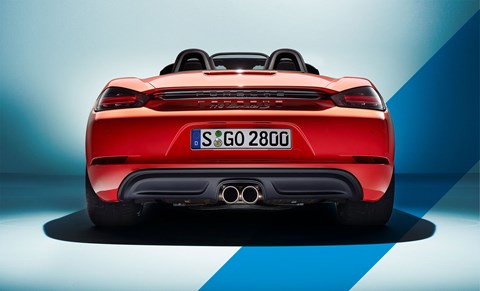
Even when grandmaster drift himself is tap-dancing on the pedals like Fred Astaire, we find it impossible to decipher a difference in outright poke and absolute torque in these conditions. From a purely subjective point of view, the 2.0-litre engine feels fractionally more agile and spontaneous, the response to tip-in and tip-out inputs bordering on restlessness.
Despite the extra 500cc, the bigger unit does not seem to obey throttle orders quite as promptly. In the wake of that brief initial – dare we say it – turbo lag, however, oomph builds up more rapidly and climbs to a taller peak. The Sport Chrono pack is all it takes to make detours to Dynamicland more exciting. One push at the black Sport Response button (SRB) in the middle of the rotary control attached to the steering-wheel kicks all systems into Sport Plus mode for up to 20 seconds. Simultaneously, the PDK transmission permits later upshifts at higher revs. No revolution, but a nice new feature.
‘Today, naturally aspirated and turbocharged engines still live side by side,’ states engineer Hofstetter. ‘In the future, however, the turbo is going to pull away big time. It doesn’t only radically replot the torque curve, it’s also an essential CO2-reducing tool.’ So, if your loyalty to the flat-six is cast in concrete, better grab a late-model Boxster/Cayman GTS, or trade up to the 911.
The fact that Porsche has given the new Boxster its own internal designation (981) indicates that the 718 is more of a new car than a routine facelift. This is good news, except that even brand fetishists must look twice to decipher the changes. Porsche developed a new instrument panel for both models mainly to get rid of the noisy yet relatively breathless old air vents – but such a luxurious degree of perfection may soon be history.
As far as the exterior goes, r&d chose to redesign all sheet metal and composite parts bar the rear bootlid. The sole eye-catching novelties are those restyled LED lights, front and rear: four bright dots per unit, plus a set of horizontal light bars operating indicators and rear lights. More advanced options such as a fully adaptive matrix beam system, the long overdue head-up display and truly intuitive ergonomics must wait until late 2020, when project 983 takes over, and the first battery-operated derivatives of both models are expected to appear.
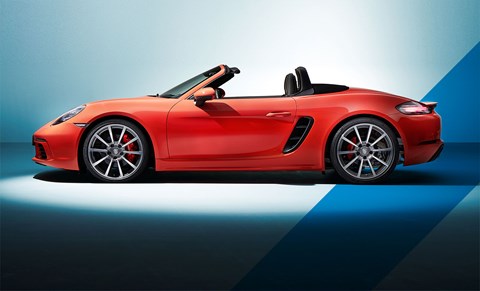
Meanwhile back in Yellowknife we’re on the trail of those crucial chassis dynamics – Porsche’s stated aim being to bring the Boxster’s rating ‘even closer to ten out of ten points.’ One important means to this end is the electrically assisted power steering. With only 2.5 turns from lock to lock, it is now 10% quicker yet at the same time a touch more stoic around the straight-ahead position. While the base Boxster receives the bigger brakes from the outgoing S model, the new S decelerates its front wheels with an assembly borrowed from the 911.
To make room for the additional plumbing and cooling requirements, the rear chassis cradle had to be re-engineered. As a result, there are now four instead of three engine and transmission mounts. The available hydraulic driveline dampers effectively reduce upshift jolts and lift-off kicks. Even though the base suspension setting is a convincing compromise, the adaptive PASM dampers are better still at soaking up potholes and neutralising expansion joints. Not quite firm and precise enough? Then hit the Sport button and dial in a tauter setting which ties the car down nicely without sending shockwaves through the partially aluminium structure.
‘More than anything else we aimed at improving the overall driveability,’ says Joachim Meyer, senior chassis engineer of the sports car division. ‘At the end of the day, it’s often the little things which add up to a tangible step forward. I’m thinking of minor changes like half an inch wider rear wheels, a new rubber compound providing more tyre grip, mildly tweaked suspension kinematics and the more sensitive ABS, ASR and PSM software.’
From the passenger’s point of view, compliance and stability are indeed more confidence-inspiring than ever. Even when ploughing through fluffy, five-inch powder, straddling icy longitudinal grooves and crossing islands of packed snow, the car remains communicative and controllable. Although some surfaces have the friction coefficient of a banana skin, the amazing Michelins, the attentive suspension and the astute electronic helpers warrant a surprise-free balance.
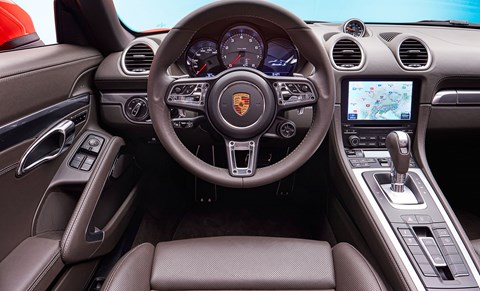
Manual transmission or PDK? The progressive clutch, the eager throttle and the slick gearlever meet the expectations of the driver’s left foot and right arm with aplomb. But this is Canada in mid-winter, and on snow the dual-clutch PDK ’box would be our preferred option. It allows you to keep both hands on the steering-wheel at all times, and the quick paddle-induced gear changes don’t dent the flow nearly as conspicuously as the two-second manual upshifts.
The characteristics of drivetrain and suspension may in combination with the Sport Chrono pack be adjusted via a rotary control knob attached to the steering wheel. There are four settings on offer: Zero indicates comfort, Sport alerts all six senses, Sport Plus is a hyper-nervous track-only programme, Individual invites you to compile personal favourites. Unlike most rivals, Porsche wisely refuses to include the steering action in this drive mode Scrabble which is, in a questionable move under preparation elsewhere, about to encompass the brake response.
Even though tight corners are about as rare in Canada’s northernmost province as Loden coats in the Sahara desert, Alex Ernst keeps unearthing secluded by-ways where the test drivers are invited to give ’em stick until colonies of Arctic hares line up along the road and applaud. Our group is a mixed bunch of 20 engineers from all faculties, two mechanics plus 700kg of spare parts packed in a Ford Expedition chase car, and a minivan acting as rolling pantry. The weekly curriculum typically consists of seven ten-hour stints at up to 700km per stage.
Back-up work on the laptop and in temporarily booked garages counts extra. Some Porsche r&d pros have been returning to the frozen badlands for 15 years in a row and know every bison by its Christian name. Even the local cops are old hands, typically turning a blind eye should a Porsche mule mistake Mackenzie Highway for the German autobahn. ‘Triple-figure stints on public roads are a no go,’ promises Ernst. ‘When we feel like playing, the fleet retreats to the lake.’ Not this winter, though – the lake’s not fit for purpose. The new Boxster, however, will be fit for purpose. That you can count on.
The breakdown
Six-speed manual is standard, dual-clutch PDK an option. Add the 911’s Sport Chrono pack to get four tunable drivetrain settings (Normal, Sport, Sport Plus, Individual), including Sport Response button with PDK. Spec the active suspension to drop ride height by 10mm (20mm on Boxster S).
Turbo engines are more efficient. Fuel consumption improves by 5.1mpg to 40.9. Prices start at £41,739 or £50,695 for Boxster S – a hike of £2186/£2837.
Mid-mounted 2.0-litre single-turbo four-pot boxer engine develops 295bhp/280lb ft (33bhp/73lb ft more than the 2.7-litre flat-six). No room in here for the turbo six! Boxster S’s 2.5-litre unit packs 345bhp and 310lb ft.
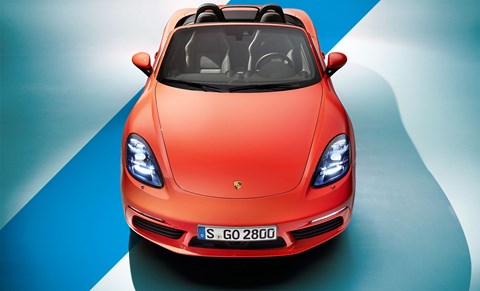
It may look familiar but every external element has been changed apart from the windscreen, luggage lid and convertible roof. Note larger front intakes, new LEDs, and new arch and sill panels. At the rear the lights are redesigned and there’s a huge new integrated Porsche badge.
Dashboard has been redesigned to take the latest version of the PCM infotainment system, which now becomes standard fit. Don’t get too excited though – even laying down in excess of £40k doesn’t bag you standard sat-nav. And with slightly ho-hum ergonomics and still no head-up display, you’re buying for the love of driving (and the love of that steering wheel).
Read more from the March 2016 issue of CAR magazine